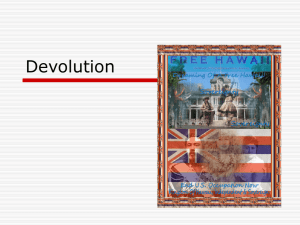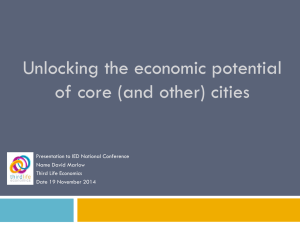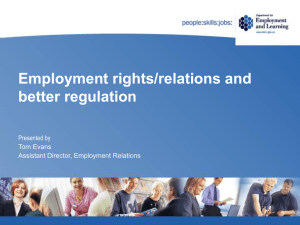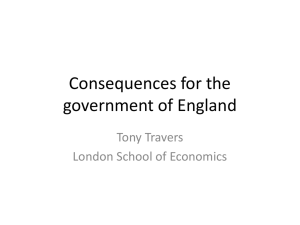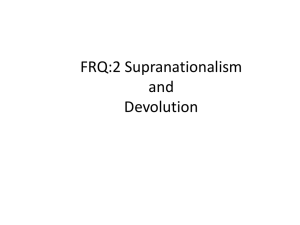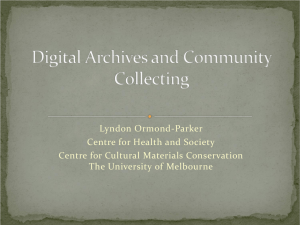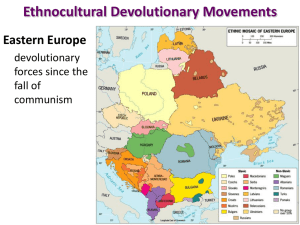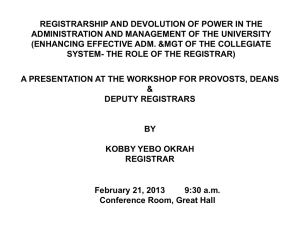What is devolution? - The National Archives
advertisement
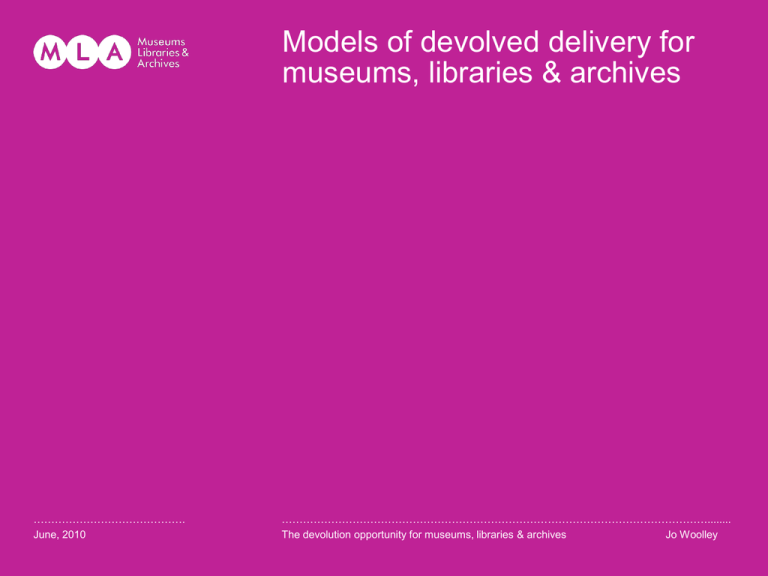
Models of devolved delivery for museums, libraries & archives ……………………………………. June, 2010 …………………………………………………………………………………………………………........ The devolution opportunity for museums, libraries & archives Jo Woolley Structure of discussion 1. Context What & why 2. Comparative assessment 3 models of devolution 3. Final thoughts 02 ……………………………………. June, 2010 …………………………………………………………………………………………………………........ The devolution opportunity for museums, libraries & archives Jo Woolley 1.1 Context: what is it? (1/5) What is devolution? What does it look like? Devolution is the transfer of strategic and financial control Traditionally single service charities over its services from local authority to a separate organisation: • A charity or trust (philanthropic) • A private sector company (investment) • A new or existing social business (enterprise) ……………………………………. June, 2010 But scenario now varying with new emergent models: • Merging services • Northumberland Museum & Archive • Sport & Culture Glasgow • Merging boundaries • Greenwich Leisure • Merging with the third sector • Salford Museum …………………………………………………………………………………………………………........ The devolution opportunity for museums, libraries & archives Jo Woolley 1.2 Context: why explore it? (2/5) Why devolve? • To gain savings • To keep services open in communities threatened with closure • To make it easier to fundraise – people don’t give to councils • To gain increased independence – external bodies have stronger voices • To gain increased expertise / skills • To embed a different culture • To become sustainable & vary sources of support ……………………………………. June, 2010 …………………………………………………………………………………………………………........ The devolution opportunity for museums, libraries & archives Jo Woolley 1.3 Why devolve? becoming sustainable (3/3) Efficiencies Earning • Fiscal exemptions • Philanthropy & gift aid • Low operating cost • Entrepreneurialism Assets • Asset transfer (building, land, collections) • Endowment • Charges & admissions ……………………………………. June, 2010 …………………………………………………………………………………………………………........ The devolution opportunity for museums, libraries & archives Jo Woolley 1.4 Why devolve: social change (4/3) Devolution can help the sector deliver social change • Charitable delivery for public benefit • Community delivery • Staff ownership • Private sector partnerships Economic regeneration Community empowerment Big Society ……………………………………. June, 2010 …………………………………………………………………………………………………………........ The devolution opportunity for museums, libraries & archives Jo Woolley 1.3 Devolution: summary Social change (5/3) Financial change • Economic regeneration • Managing cuts to budgets & resources • Community and Big Society • Making savings • As well as state delivery: • Charity delivery • Community delivery • Staff ownership • Private sector partnerships • Economies of scale • Merging with cultural services • Merging across boundaries • Integration with third sector Achieving more… ……………………………………. June, 2010 … with less …………………………………………………………………………………………………………........ The devolution opportunity for museums, libraries & archives Jo Woolley Structure of discussion 1. Context What & why 2. Comparative assessment 3 models of devolution 3. Final thoughts 08 ……………………………………. June, 2010 …………………………………………………………………………………………………………........ The devolution opportunity for museums, libraries & archives Jo Woolley 2.1 Philanthropic: applicability of format Fundamentals • Charity or trust • Most common devolution format – 120 charitable leisure trusts devolved from direct delivery (sports) – 2006 museums survey: 76% councils delivered directly, 8% trusts – Archives sector has some independent charitable models • Charities can fundraise: attract grant funding and user donations Key strengths • Charities can trade and enter into business partnerships • Charities can benefit from the most tax exemptions of all models • Charities well placed to earn the income to scale up & grow ……………………………………. June, 2010 …………………………………………………………………………………………………………........ The devolution opportunity for museums, libraries & archives Jo Woolley 2.1 Philanthropic: managing risk Key risk • Competition: UK cultural sector earns lots from fundraising - Fundraising traditionally low for regional mlas - Philanthropy is not ‘free’ - market becoming more competitive - Statutory right to ‘free’ service models makes it a big culture change • More single services charities, the greater likelihood of growth slowing Other risks • Model offers least versatility for partnerships at board level • Most devolved cultural services yet to exploit fundraising and gift aid - if not prepared to ask for donations why become a charity? ……………………………………. June, 2010 …………………………………………………………………………………………………………........ The devolution opportunity for museums, libraries & archives Jo Woolley 2.2 Investment: applicability of format Fundamentals • Models that contract private sector involvement – for profit • Second most common form of devolution • >1% museums in 2006 and two library services • Partnership working Key strengths • Associated with efficiency - and delivers - but not unique to model • Unique capacity for significant investment to restore deteriorating assets • Guarantee long term, year on year funding or budget projections ……………………………………. June, 2010 …………………………………………………………………………………………………………........ The devolution opportunity for museums, libraries & archives Jo Woolley 2.2 Investment: managing risk Key risk Other risks • Primary focus of investment models will be to achieve efficiency - unless significant consumer demand influences service provision • Risk of creating virtual monopolies driving improved but homogenised services rather than ones determined by need • Risk to integral service improvement & skills growth • Least potential to exploit full range of income opportunity – • private benefit puts off philanthropy • greater challenges in asset transfer • Over time investment is likely to be offset by gross profit ……………………………………. June, 2010 2.3 Community enterprise: applicability of format Fundamentals • Delivery of cultural services by social enterprises – for ‘profit’ • Little sector take up but third sector growth area - as charities but also social enterprises, community or staff ownership models • Uniquely flexible governance formats for collaborative partnerships Key benefits • Good income opportunities -philanthropy, investment • Can create economic impact within deprived areas • Demonstrable operational efficiencies ……………………………………. June, 2010 …………………………………………………………………………………………………………........ The devolution opportunity for museums, libraries & archives Jo Woolley 2.3 Community enterprise: managing risk Key risk Other risks • Transfer of assets – land, collections, building, money – for success • shared body of experience in assessing this area of risk – Quirk, DTA, Community Matters, BIG and ACF • Need for strong leadership to think laterally and opportunistically about income generation • Challenge for the cultural sector in managing the compatibility of charged services with a free core service • Achieving diversity –sections of community or workforce can be • excluded from participation (offset by good workforce policy) ……………………………………. June, 2010 …………………………………………………………………………………………………………........ The devolution opportunity for museums, libraries & archives Jo Woolley Structure of discussion 1. Context What & why 2. Comparative assessment 3 models of devolution 3. Final thoughts 015 ……………………………………. June, 2010 …………………………………………………………………………………………………………........ The devolution opportunity for museums, libraries & archives Jo Woolley 3.1 How MLA can help Strategic analysis The opportunity of devolved governance for museums libraries and archives • range of models applicable to museums, libraries and archives • assessment of strengths and weaknesses of each legal format • ‘best practice’ case studies Practical guidance (1/2) The Field Team An online resource available shortly including Practical advice and support • A feasibility framework for developing trust options for museum services • Your Field Team can advise with options appraisals around devolution • A guide to the review process and legal transfer issues • Precedent legal documents to save replication costs from local authority to local authority • Strategically, Field Teams can help broker networks and relationships, and help develop collaborative working with the third and private sectors • key areas of risk ……………………………………. June, 2010 • Regional workshops …………………………………………………………………………………………………………........ The devolution opportunity for museums, libraries & archives Jo Woolley Final thoughts There is more than one devolution model Devolution is a strategic response to more than one political imperative - sector improvement, economic recovery, Big Society. Different devolution models will support different outcomes. Selection should be based on local need and appropriateness rather than what has worked elsewhere. Devolution is an option open to any service With the right plan in place there is no reason to suppose that any service – single or joint, high or low performing, museum library or archive – could not successfully devolve. Any questions? 3.3 Planning a model (3/4) Assets transferred Assets protected Organisational strengths • Protects sector specialism • Empowers leadership & mission • Supports accreditation and standards • Applicable to single and joint services • Competitive • Works with strategic commissioning • Can support community delivery Market strengths Financial strengths • Supports philanthropy • Supports enterprise • Tax exemptions • Restricted reserves Secure funding stream BUT • Unsustainable • Short term annual funding • Inward investment driven • Inefficient • lacks economies of scale Policy led Specialist, centralised accountability and often high standard BUT: • Least productive • Limited flex • Lack of capacity Direct delivery ……………………………………. June, 2010 Outcomes driven • Enables cross discipline working • Empowers leadership & mission • Highly flexible • Applicable to joint services • Drives collaboration & partnership • Private sector appeal • Highly market responsive • Supports enterprise • Supports philanthropy • Supports investment • NNDR exemptions • High efficiency savings • Unrestricted reserves • Inward investment • Long term budget • Profit driven • High efficiency savings • Supports single service • Can support collaborations • Supports public private partnerships • Highly market responsive • Directly accountable to govt • Protects sector specialism • Supports fixed standards & delivery • Highly flexible Performance driven Private management User focussed BUT: • Static model, limited growth prospects • Limited capacity for rapid response • Limited integration with other services/ local priorities - single service Community owned Community management Public benefit led Philanthropic Investment model …………………………………………………………………………………………………………........ The devolution opportunity for museums, libraries & archives Jo Woolley Appendix: Legal formats & their characteristics Charities Industrial Provident Society Community Interest Companies Community Benefit / Land Trusts Limited Liability Partnerships Companies Limited by Guarantee) • Hybrid corporate body combining limited liability with advantageous tax characteristics and organisational flex • NPDO with restricted objects and prohibition on profit distribution but light touch regulation of Companies House • Access loan finance, mortgages, unrestricted reserves • Membership includes private & public sectors • Collaborative • Can assimilate other models but can’t be sold • Tax applied as partnership - only liable on member share • Unrestricted reserves • Supports public private ventures • Unlimited flex • NNDR savings and some VAT; some grants; unrestricted reserves • Flexible model for private sector partnership (group structure) • Directors paid • Can form CICs • No tax benefits • Arguably limited philanthropy • Shareholders can change purpose – claw-back clauses • Democratic format could discourage scaling up geographically • Limitations on constitutional form they take • NO NNDR exemptions • Ineligible for grant/ social enterprise funding • No asset lock • Ineligible for much grant funding • Prohibition on profit distribution can reduce appeal • No asset locks • Regeneration in deprived areas • Broker relationships between sectors • Empowering small / specialist services for full devolution • Furthering programme of asset transfer & participation • PFI opportunities CLT own freehold • robust for private sector but flexible for social enterprise PPP • Profits donated to claim gift aid • Could be useful ‘first step’ model as allows LA to retain control and can transfer to other formats when ready NPDOs for public benefit CCLG CLG CIO UCO NPDOs or profit distributing • Community Benefit Society • Co-operative Business activity for community benefit • Limited by guarantee • Limited by share Defined by statute (H&R Act 2008) Democratic corporate body holding property for community. Tax exemptions inc gift aid Trusted format Protected liability Asset lock Risk averse regulation Subsidiary structures • Charitable fiscal benefits • Model designed to generate income • Risk averse regulation • Can offer democratic governance • Eligible for grants, loan finance, unrestricted reserves; supports enterprise & income • Collaborative • Reliable regulation & asset lock • Board members paid = accountability Tax on enterprise No debt finance Limited reserves Competitive Board membership less accountable • High set up costs • Competitive rather than collaborative • Cumbersome administrative & regulatory structure A LA in PPP able to use funding to lever philanthropy and claim gift aid • Cross--domain leisure & cultural services to earn revenue & decrease LA investment over time
